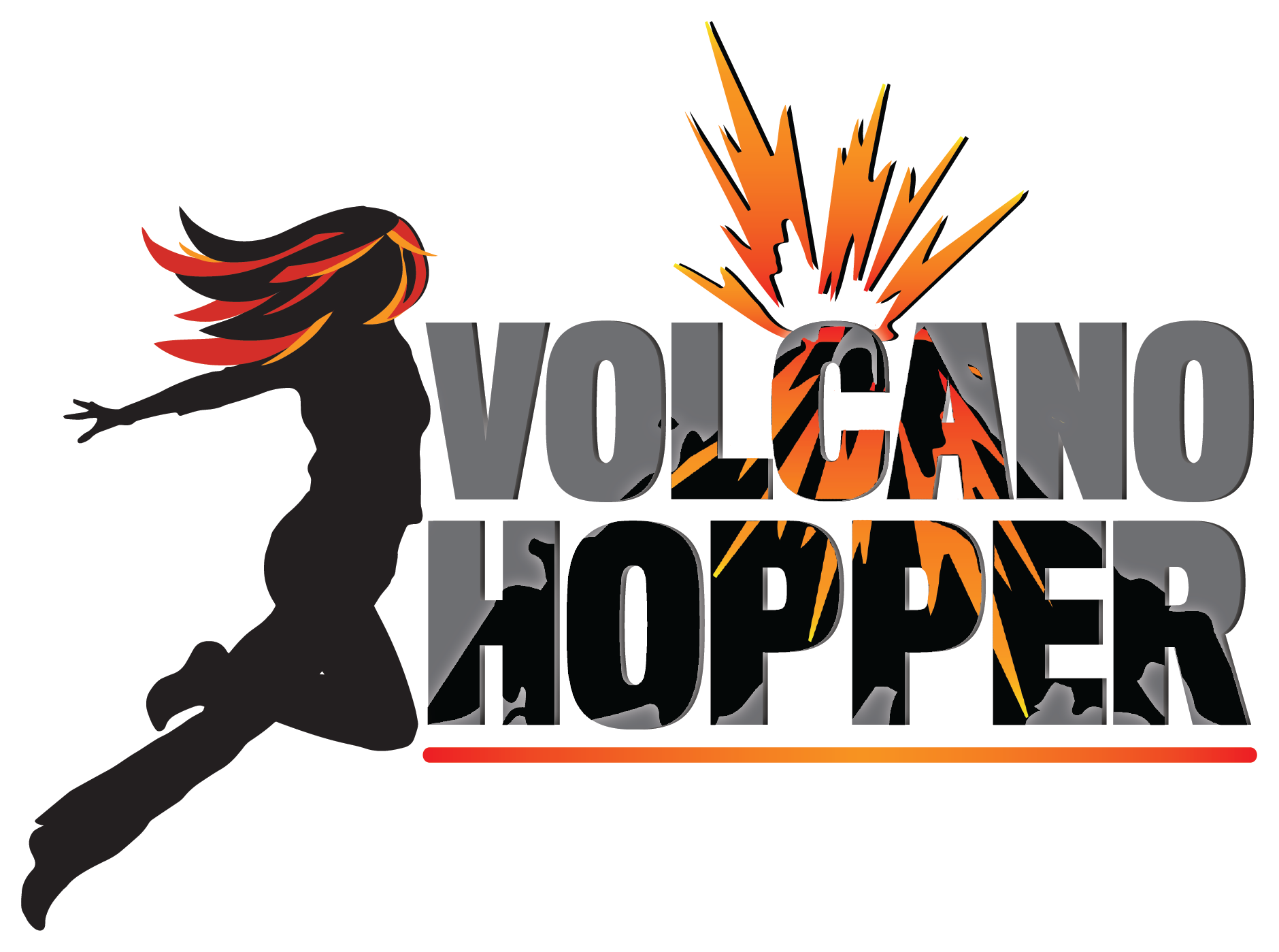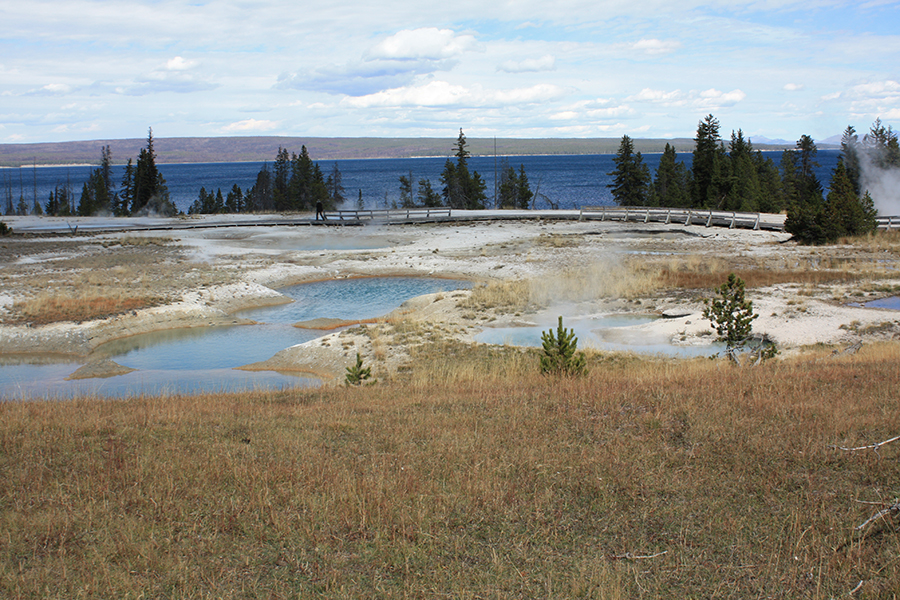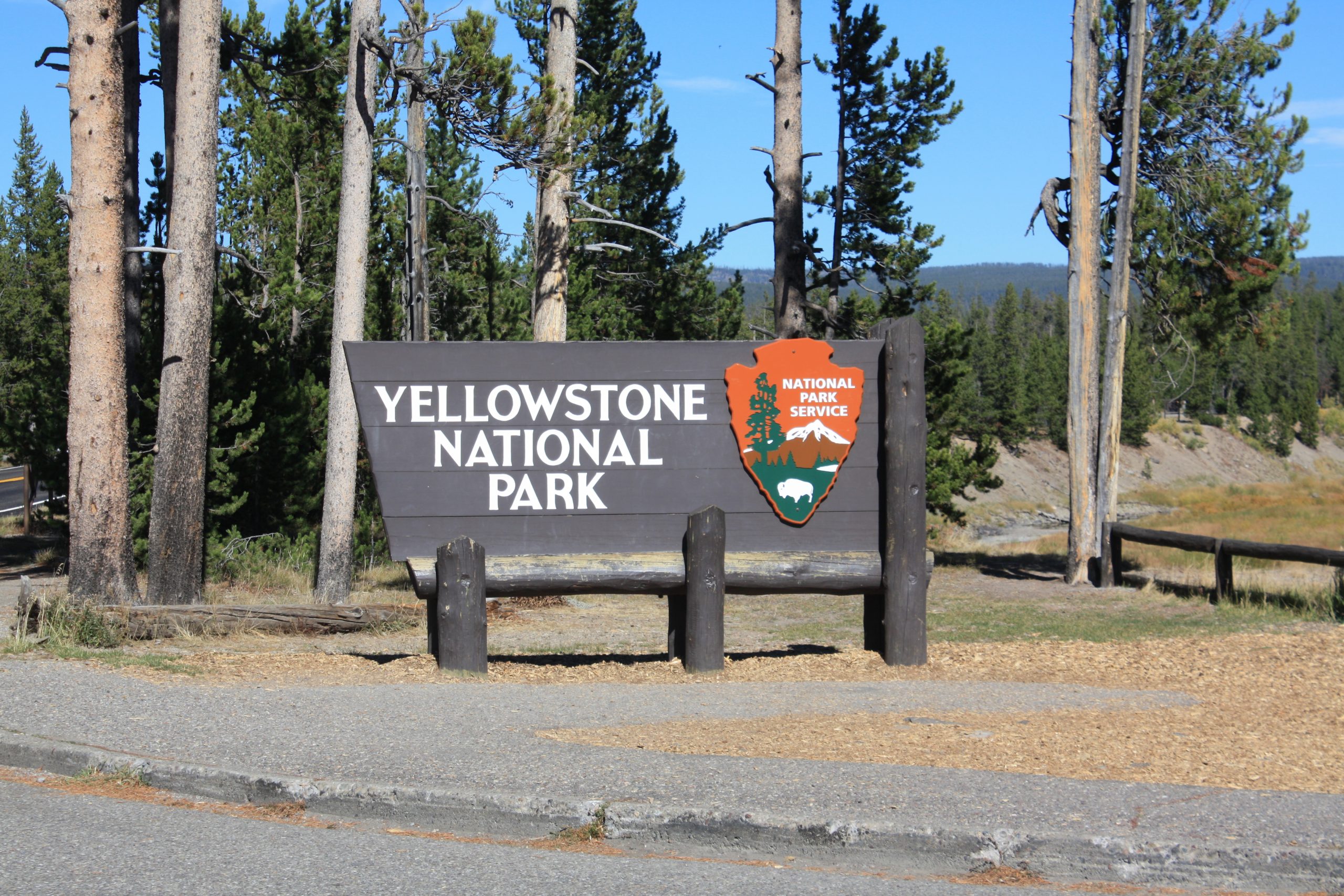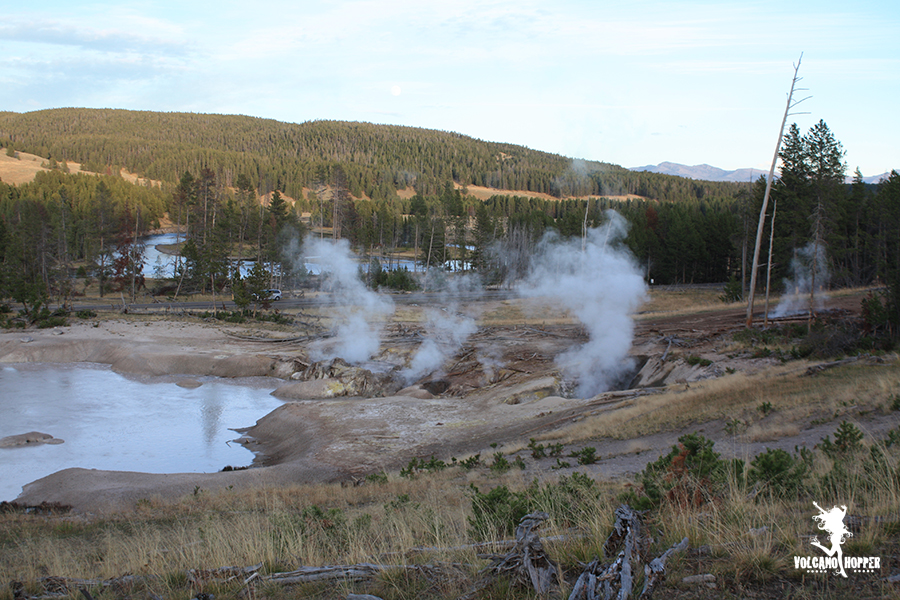Vital Stats
Name: Yellowstone
Type: Supervolcano
Eruption Status: Active
Last Eruption: Approximately 640,000 years ago
Location: 44.4280° N, 110.5885° W
Northwestern Wyoming/Southeastern Idaho
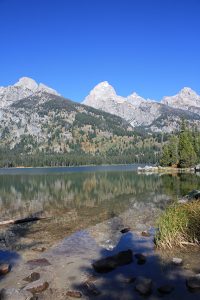
It was a long drive to Yellowstone through a lot of flat and rather uninteresting prairie, but we made it. The late afternoon sun was pouring down onto the golden autumn leaves and making the creek sparkle. Instead of heading directly into Yellowstone, my partner in crime and I took a detour south toward Jackson. We stopped at a few places along the Grand Tetons and did a little hiking at Taggart Lake to stretch our legs. These mountains are not volcanic, but they certainly are magnificent. Bathed in the rich colors of fall, they were a sight not to be missed. While you’re in the area, make sure you stop and take a look. You won’t be disappointed.
And of course, if you’re hankering for some pretty darn delicious food, don’t miss the Gun Barrel restaurant down in Jackson and take a bite of their bison prime rib. Yum. Just… yum.
With a good night’s sleep and incredible dinner under our belts, we were ready to set off in search of some adventure. I had been quivering with delight knowing that one of the biggest volcanoes on earth sat just over an hour away. Now my feet were itching to get my boots on the ground and go exploring.
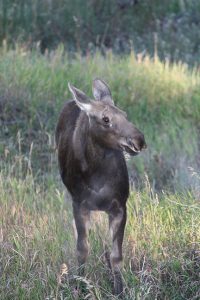
We headed North from Jackson, taking the south entrance into the park. The area is heavily forested, but make sure to keep your eyes peeled for wildlife just off the road. If you see a bunch of cars pulled over in one spot, it’s likely that they’re watching something really cool! This area is a popular hangout for moose, and we were lucky enough to spot a momma and baby moose grazing for some lunch!
As you wind through the forest, you’ll spot Lewis River and Lewis Falls on your left. Lewis Falls tumbles beautifully down a ridge before the river runs into Lewis Lake. This ridge is the southern boundary of the Yellowstone Caldera from the most recent eruption 640,000 years ago.
While the Yellowstone hot spot has caused 142 eruptions and countless minor ones, spanning from Nevada to Idaho, only 3 eruptions have happened within the current park boundaries:
- 2.1 Million Years Ago – this was the biggest, baddest of them all, ejecting enough material to overflow the Great Lakes.
- 1.3 Million Years Ago
- 640,000 Years Ago – this is the age of the most recent caldera.
Aside from these 3 mega-colossal or “super” eruptions, there have been 80 smaller eruptions and lava flows, the most recent being 70,000 years ago.
Yellowstone is formed by a hot spot that burns its way through the mantle. The layer of crust that it has burned through is typically rich in rhyolite. Rhyolite is rich in silica, which means that it has a very high viscosity and does not flow well. Imagine watching peanut butter flow from the jar. Because it is sticky and highly viscous, when it decides to go, it explodes. When the pressure that is constantly held on the magma is suddenly released, water and carbon dioxide degass extremely rapidly. This causes the explosion.
Here’s another fascinating phenomenon about rhyolitic magma: Take a suitcase and fill it with this type of magma. Add 5% water to the magma, zip it closed, and set it in your living room. Ok, stand back. Pop the bag and boom! Not only does it explode, but it expands. Rhyolitic magma + 5% water expands over 670 times! That suitcase worth of magma is now filling your living room and busting out the windows like a foam experiment gone wild.
So now that you’re crossing into a caldera that is 45 miles by 30 miles in diameter, you can imagine how much magma was erupted into the air and, when it expanded, how dramatic an eruption it really was!
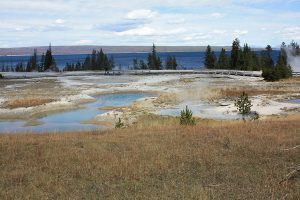
If you keep driving past Lewis Lake, a few miles up the road you’ll come to Grant Village and West Thumb Geyser Basin. Off to your right, you can see the wide expanse of Yellowstone Lake, fringed by the once volcanic Absaroka mountains. The round section of lake closest to you is actually a 150,000 year old explosion caldera that filled with water and expanded the lake. And in between you and the lake is an active geyser basin just waiting for you to explore it!
You’ll find a little bit of everything here – geysers, hot springs, mud pots, fumaroles – a great sample platter to sink your teeth into! This geyser basin erupts 3,100 gallons of water per day into the nearby lake. Talk about active! You can wander through many of the feature on the shore, but don’t forget to take a peek out into the lake. Many of the geysers sit just offshore and only make guest appearances when the lake levels fall in the summer. And, if you have some extra time, stick around for a tour led by a naturalist.
One thing to remember before you go exploring: STAY ON THE BOARDWALK. Look me in the eye and promise me you won’t set foot off of it. The ground is unstable, and everything (water, steam, ground) is insanely hot. It WILL kill you. Got it? I don’t want to hear about you getting scorched to death on the evening news.
Ok. Now that you’re off and running, here are some notable feature to check out:
Fishing Cone
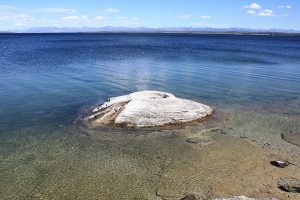
This is a conical geyser that sits just offshore of the geyser basin. Legend states that a fisherman could stand atop the geyer and catch fish from the lake, turn around, and dunk it in the boiling waters of the geyser to cook it. That’s about as fresh as you can get! Many people tried this in years past and some succeeded, but they also succeded in causing damage to the geyser. Nowadays, it’s illegal to fish from the geyser.
Lakeshore Geyser
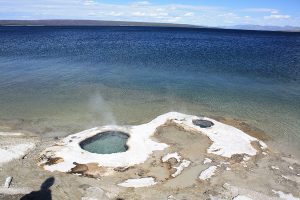
Photo Credit: Volcano Hopper
This geyser sits just offshore and is dormant when the lake water covers it. Lakeshore Geyser, when not submerged, tends to be rather rowdy and can shoot water up to 30 feet in the air.
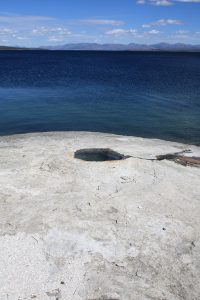
Photo Credit: Volcano Hopper
Big Cone
Like Lakeshore Geyser, Big Cone sits just offshore and is dormant when submerged. Big Cone often causes holes to melt and open in the lake ice during the winter.
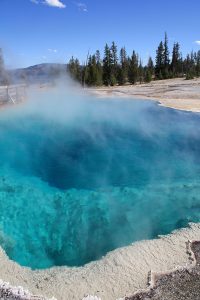
Photo Credit: Volcano Hopper
Black Pool
This is one of the most beautiful pools in Yellowstone. It once had a low water temperature that allowed dark green and brown thermophiles to grow inside it, giving it its name. The temperature in this pool rose dramatically in the early 1990’s, which killed off all of the thermophiles and changed the color of the water to a deep, clear blue.
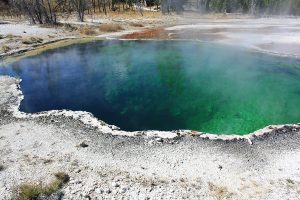
Photo Credit: Volcano Hopper
Abyss Pool
At 53 feet deep, this is one of the deepest hot springs in the park. The pool is deceptively quiet – in past years, its eruptions spewed water violently up to 80 feet in the air. It has since grown tranquil and quiet with intermittent eruptions few and far between.
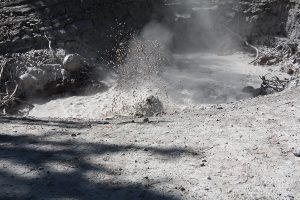
Photo Credit: Volcano Hopper
Thumb Paint Pots
These brightly colored little mud volcanoes used to be 3-4 feet in height and would spit mud up to 25 feet in the air. They are far less active today then when first discovered in 1871.
Just past the geyser basin and West Thumb, the rest of Yellowstone Lake spans the near horizon. The fishing here is excellent, but it’s a terrible place to take a swim. The water temperatures in the summer are only a mere 45 degrees Fahrenheit, and your body could only take that amount of cold for 20 minutes. Better to admire it from dry land, or a boat.
Yellowstone Lake is the largest high altitude lake in North America, sitting at 7,733 feet above sea level. It is approximately 136 square miles, and its deepest point is almost 400 feet below water. The cold temperature and depth make it difficult to explore, but with recent advances in robotic technology, scientists have been able to take a deeper look at what lies beneath its waves. They have found active gas pockets that make the water bubbly and hot, and have found a huge variety of other thermal activities beneath the waves.
A few years ago, a boat wreck that had previously been submerged under water rose up out of the lake like a ghost ship. Scientists found that the ground beneath the lake had been uplifting as the volcano breathed and the ground expanded. The ground lifted the boat right out of the water! The rising and falling of the land here beneath Yellowstone Lake causes trees to be submerged and beaches that were long underwater to be exposed.
As you drive to the northeast from West Thumb, the road winds along the lake, offering fantastic views of the water and mountains beyond. Wildlife is common here, so drive slowly and enjoy the scenery. We had an elk or two bounce across our path in this section of the park. You can stop along the way at the Bridge Bay Marina if you plan on boating, or at the Fishing Bridge if you want to try your hand at catching dinner.
Once the sun goes down, it’s blacker than black out here in the park. But if you can stand the night chill, bundle up and take a peek up at the sky. The stars are absolutely brilliant out here. Nothing cuts a cup of hot cocoa while gazing up at the band of the Milky Way.
We cozied up in a little cabin at Lake Lodge to spend the night. No tv, no radio, no cell phones or Internet. We were off the grid. And it was wonderful. Nothing like some time away from the general hubbub of life to refresh your mind and spirit.
Off to sleep, now… And up again at first light to do more exploring!
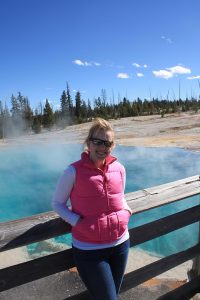
Up Next: The East Side of Yellowstone: Hayden Valley, Mud Volcano, and the Sulfur Cauldron
Want more pictures? Check out our Facebook page!
